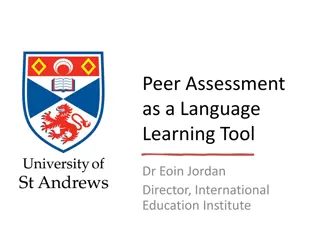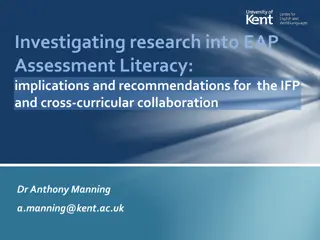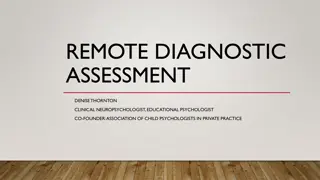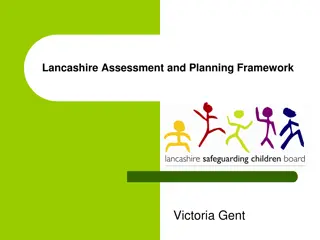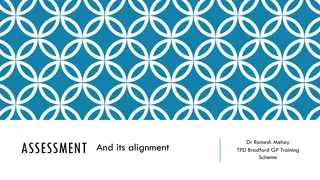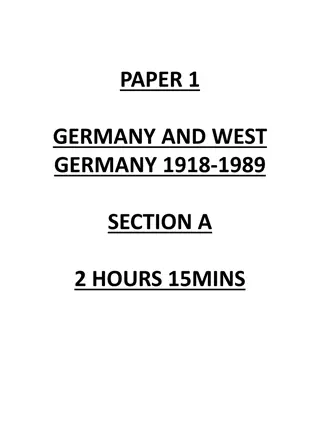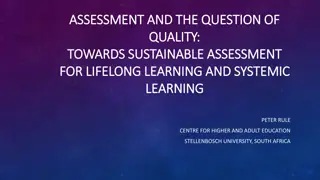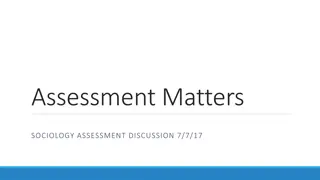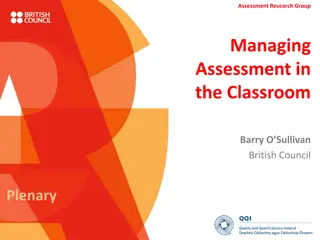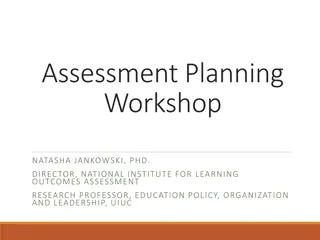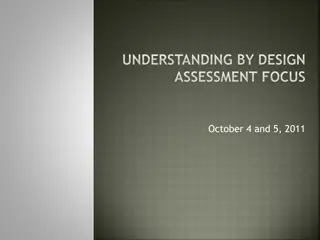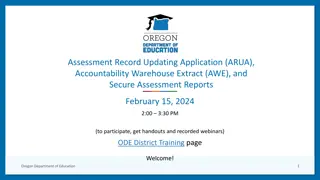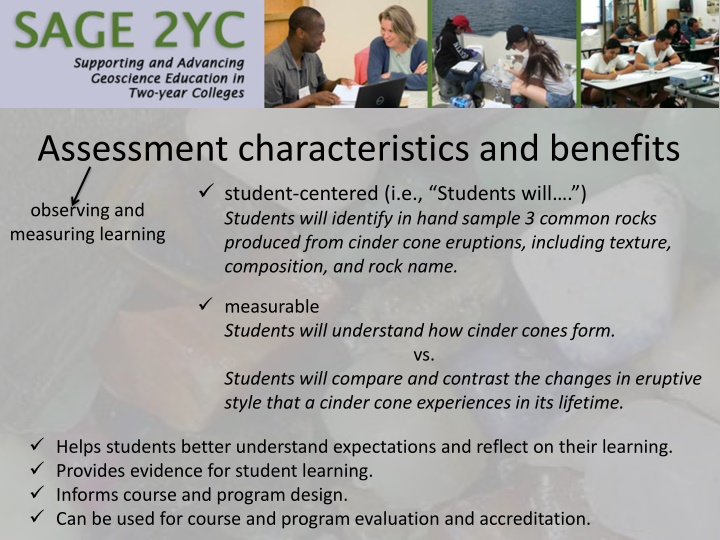
Effective Assessment Strategies for Student-Centered Learning
Explore various student-centered assessment strategies including formative vs. summative assessments, examples of assessments, and the benefits of using interactive testing systems like IF-AT and case studies. Enhance student learning outcomes and engagement through targeted assessment approaches.
Download Presentation

Please find below an Image/Link to download the presentation.
The content on the website is provided AS IS for your information and personal use only. It may not be sold, licensed, or shared on other websites without obtaining consent from the author. If you encounter any issues during the download, it is possible that the publisher has removed the file from their server.
You are allowed to download the files provided on this website for personal or commercial use, subject to the condition that they are used lawfully. All files are the property of their respective owners.
The content on the website is provided AS IS for your information and personal use only. It may not be sold, licensed, or shared on other websites without obtaining consent from the author.
E N D
Presentation Transcript
Assessment characteristics and benefits student-centered (i.e., Students will . ) Students will identify in hand sample 3 common rocks produced from cinder cone eruptions, including texture, composition, and rock name. observing and measuring learning measurable Students will understand how cinder cones form. Students will compare and contrast the changes in eruptive style that a cinder cone experiences in its lifetime. vs. Helps students better understand expectations and reflect on their learning. Provides evidence for student learning. Informs course and program design. Can be used for course and program evaluation and accreditation.
Formative assessment vs. summative assessment Assessment forlearning . Assessment oflearning . Occurs during the learning process. Occurs at the end of the activity, module, course, etc. Provides immediate feedback. Feedback does not happen in real time. Typically low-stakes. Typically higher stakes. Engages students in active learning. Typically evaluates a student product.
Assessment Examples Formative Brainstorming Case studies Concept maps Diagnostic question clusters Drawing pictures or diagrams IF-AT Immediate Response Systems Just in time teaching One-Minute Papers Poll Anywhere/Kahoot It Quizzes Reading Assessments Statement Correction Strip Sequences Team-Based Learning Think-Pair-Share Descriptions of assessment strategies from Dirks, C., Wenderoth, M.P., and Withers, M., 2014, Assessment in the College Classroom. Summative MC Exams Free Response Exams Essays Group Exams Oral Exams Practical Exams Open Book or Open Note Exams Presentations Written Reports Portfolios Peer-Led Team Learning Rubrics
IF-AT Intended learning outcome: Students will retrieve and apply prior knowledge to answer questions and employ feedback to correct misconceptions. How it works: Answer-until-correct interactive testing system (scratch-off). Benefits: Students and faculty get immediate feedback. Promotes peer collaboration. Useful in a variety of class sizes and formats. Low-stakes practice answering multiple-choice questions. May highlight misconceptions. Example: stay tuned!
Case Studies (as an assessment strategy) Intended learning outcome: Students will evaluate a real-life problem and apply their knowledge and understanding to solve it. How it works: Students work through (real or hypothetical) scenarios during which they apply scientific concepts to social, ethical, political, or research-based dilemmas.1 Benefits: Fosters scientific habits of mind and higher order thinking skills. Students are interested in place-based learning and societally relevant topics. Examples: National Center for Case Study Teaching in Science; Boulder Creek hazard mapping
Statement Correction Intended learning outcome: Students will evaluate a statement and apply their understanding to correct mistakes. How it works: Students identify the error in a statement and discuss possible corrections with a partner or group. Example: Several students have incorrect statements, like: Convergent boundaries between ocean and continental asthenosphere, like the one between the South American Plate and the Nazca Plate, result in the creation of lithosphere and are characterized by mid-ocean ridges. then they have to go around the room to find the 2-3 students who have the correct terms.
Strip Sequence Intended Learning Outcome: Students will evaluate a process and apply their understanding to recreate the logical steps of the process. How it works: Students work with a partner or group to place the steps of a process in the appropriate logical order. Example: Development of an angular unconformity to facilitate an understanding of geologic time Deposition, uplift, lithification, burial, deformation, uplift, deposition, etc.
Oral Exams Advantages Students can fully express their ideas Students with strong oral communication skills can showcase this talent Nearly impossible for students to cheat Disadvantages Students may be intimidated Students are not anonymous Students with weak communication skills may be negatively impacted Only a limited number of topics can be tested in an allotted amount of time Evaluation is subjective unless a validated and reliable rubric is used *presentation topics can match possible questions
Open Book/Open Note Exams Advantages Potential to shift questions from lower to higher Bloom levels Measure students ability to find and use information Disadvantages Requires more desk space May give students a false sense of security and discourage adequate preparation Students may have difficulty with time management during tests *Also a great way of getting students to buy textbook; maybe ask just a few questions or use an unanswered long essay.
Portfolios Advantages Demonstrates development of student work over time. Provides an opportunity for creative expression. Allows student work to take multiple formats. Disadvantages Students may be unfamiliar with/intimidated by the format of a portfolio. Students may take longer constructing the portfolio than considering its content. Labor-intensive evaluation Evaluation is subjective (tight, rigorous rubrics are essential) *Helpful to give students lab time to use a rubric on a test field report/portfolio entry.
Groups for the next exercise: Group 1 Randall Michael Jessica Group 2 Nicole Benjamin Hector Group 3 Group 4 Martha Mark Tor Angela Bryan Sadie
Lets try an IF-AT Each person should have an article. Each group should have a penny and a scratch form. Instructions: 5 minutes: read the article individually (won t be enough time!) On your own, answer the multiple-choice questions without referring back to the article or discussing your answers. With your teammates, reach a group consensus about the correct answer. Scratch off the group s choice. The correct answer is denoted by a star. If applicable, keep scratching until you get the correct answer. Scoring: 2 points for the star revealed on the first scratch; 1 point for the star revealed on the second scratch; 0 points for the star revealed on 3-5 scratches
Designing effective assessments (30 minutes) Please work in the same groups as the IF-AT exercise. Each person gets 10 minutes of the group s time. In those 10 minutes: 1 minute or less summarizing the activity that you brought. Include the topic and a brief description of how you run it in class. Remaining time: brainstorm with group members on some assessment strategies that you ve learned about that might work well this the activity. After 10 minutes, please move on to the next group member.
Assessment action planning (15 minutes) In your individual workspace, please respond to the two assessment- related action plan questions.



